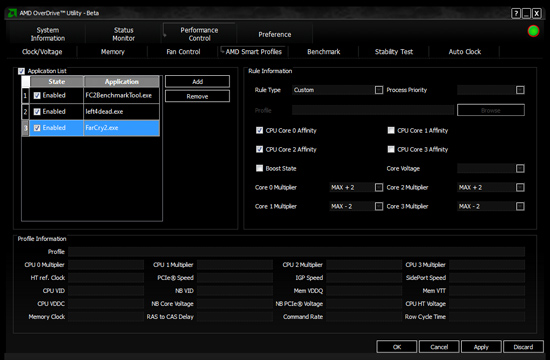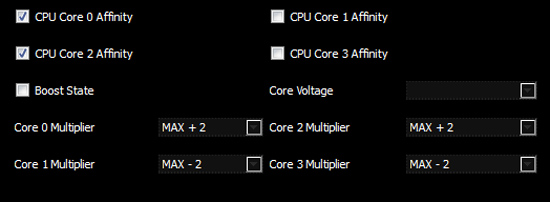AMD's Phenom II X4 955 Black Edition
by Anand Lal Shimpi on April 23, 2009 12:00 AM EST- Posted in
- CPUs
The Software Answer to Intel’s Turbo Mode
The Core i7 has its Turbo Mode. When only one core is active, power is shut off to all other cores and the active one can run at higher clock speeds. Even when all four cores are active, as long as the processor isn’t running too hot, the entire chip can run at a higher frequency. The default turbo speeds for the three i7s out on the market are listed below:
| Processor | Stock Clock Speed | Max Turbo (All Four Cores Active) | Max Turbo (One Core Active) |
| Intel Core i7-965 | 3.20GHz | 3.33GHz | 3.46GHz |
| Intel Core i7-940 | 2.93GHz | 3.06GHz | 3.20GHz |
| Intel Core i7-920 | 2.66GHz | 2.80GHz | 2.93GHz |
Turbo mode is an interesting concept because it allows end users to experience higher performance without ever having to even know about overclocking. In its first incarnation on Nehalem, Intel was quite conservative with how far they pushed Turbo. Given that our Core i7 920 had no problems running at up to 3.8GHz without increasing its core voltage, I’d say that Intel could stand to be a bit more aggressive with its turbo modes.
Note that in all of our multithreaded tests, the Core i7 has no problems running at its “turbo” frequency. In other words, the i7-920 runs at 2.80GHz far more frequently than it runs at 2.66GHz.
AMD unfortunately does not have a similar capability in its processors. Intel dedicated around 1M transistors to an on-die microcontroller called the PCU (Power Control Unit). The Core i7’s PCU tracks power consumption and manages clock speeds and voltages to ensure that the i7 always delivers the best performance when you need it, and the lowest power consumption when you don’t.
AMD didn’t go in and introduce any major architectural changes in the Phenom II X4 955 and most likely won't for a while. Instead, AMD is hoping to deliver a turbo-like feature in software.
The software is AMD’s Overdrive Utility 3.0 and the feature is called AMD Smart Profiles.

It works like this: you select an executable, and then using AOD3 you can set what cores that executable should run on and what clock speeds those cores should run at. AMD will have predefined profiles for various games but you can also create your own profiles.

Since the majority of desktop applications aren’t multithreaded, you’d stand to benefit from running two of your cores at a higher frequency and dropping the clock speed on the remaining two cores. That way you could keep power consumption unchanged, while improving performance.
It does work, I ran a quick test on Left 4 Dead and Far Cry 2:
| Processor | Left 4 Dead | Far Cry 2 |
| Smart Profiles Enabled | 124.1 fps | 53.3 fps |
| Smart Profiles Disabled | 121.4 fps | 51.2 fps |
| Performance Improvement | 2.2% | 4.1% |
In these cases the games were forced to run on two cores specifically (at least the .exe files) and those two cores were overclocked by 400MHz, while the remaining two cores were underclocked by 400MHz. The end result was that performance improved by 2% in Left 4 Dead and 4% in Far Cry 2.
There’s obviously more flexibility with AMD’s method than Intel’s and you could potentially get a much greater performance improvement. There are a couple of downsides. For starters, there’s no guarantee of stability but if you keep the overclocks mild and/or accompany them with a corresponding increase in core voltage then you can minimize that risk. The other obvious downside is that for the majority of applications and games you’ll have to create profiles manually. Honestly I’d prefer if the CPU did the work for me, but if you enjoy customizing your system then you’ll feel right at home with AOD3’s Smart Profiles.
AMD will add new profiles as time goes on. AMD does have plans for a turbo mode in future microprocessors, but we won’t see them until 2011.










65 Comments
View All Comments
poohbear - Thursday, April 23, 2009 - link
hey, is it safe to conclude that since farcry2 shows a 5% increase going from ddr3 1066 to ddr 3 1333 & another 4% going from ddr 3 1333 to ddr 1600, that overall it'd show a 9% increase switching from ddr1066 to ddr1600? that's quite a leap just based on memory!lopri - Thursday, April 23, 2009 - link
UnfortunatelySadly
Unlikely
Disappointing
Useless
Waste
Unpleasant
Painfully
Negligible
--
Luckily
Thankfully
Great
Possibility
Benefit
impressive
Once again
Surprise
Refreshing
Next up (my guess): SSD or Mac
aguilpa1 - Thursday, April 23, 2009 - link
Unfortunately - at 3.2 it can't keep up with 2.66 i7Sadly - AMD needs new architecture
Unlikely - that it will happen soone
Disappointing - results even though quality is improving
Useless - to keep comparing the lates amd to intel
Waste - of article space for these comparisons
Unpleasant - to AMD fans
Painfully - obvious AMD is far behind
Negligible - improvements with new releases
--
Luckily - there are other articles to read
Thankfully - I don't own one of these chips or mobos
Great - bunch of useless data
Possibility - AMD may pull something actually new of these days
Benefit - of better pricing and competition
impressive - how I'm still finding things to write on this
Once again - I am bored by a Tom's article
Surprise - (sorry no surprises here)
Refreshing - my post has come to an end.
Nfarce - Thursday, April 23, 2009 - link
Hahaha! I'm still waiting on the AMD whiners complaining of Anandtech anti-AMD bias every time Intel whips them.Nfarce - Thursday, April 23, 2009 - link
Oh yeah, and the fact that a stock i7 has Turbo Mode is fair game. AMD needs to produce better than this. They own the mid-range GPU market with excellent cards like the HD 4870, but their processor development just - flat - needs - help.Procurion - Thursday, April 23, 2009 - link
Not an issue-I own both AMD and Intel systems but am considering moving up from my 9950BE to the 955 and want to be sure of what I am buying before I spend my money. Some of us aren't as well versed as others in the finer points and that's what I thought the comments section was for.Procurion - Thursday, April 23, 2009 - link
I can understand some of your comments, but according to his data/listed values, the i7 920 is NOT running at stock speed. The frequency he lists is 2.8, NOT 2.66. What's up with that Anand? I can't see where you mention that your test was run with OC'd cpu's but the speed you list for the i7 920 is overclocked? It does skew the results if that is the case.Procurion - Thursday, April 23, 2009 - link
To clarify, the listed speeds for Sysmark, which would make the i7 part look much better than if you had run it at 2.66. To draw the conclusions at the end of your article without noting the difference(if there is one and it's not a typo) or justifying your conclusion with proper references of performance in 50% of your published tests is confusing to say the least. Can you clarify?Spacecomber - Thursday, April 23, 2009 - link
I'm guessing that he is showing the processor's actual speed during the test. The 2.8GHz speed likely is due to the i7's native ability to overclock itself via Turbo Mode (see page 4 of the article). In other words, the i7-920 dynamically has an actual clock speed up to 2.93GHz, depending on the application(s) running.Anand Lal Shimpi - Thursday, April 23, 2009 - link
woops, sorry for the confusion there, the i7-920 ran at its stock speed of 2.66GHz but Turbo Mode was enabled so it'll run as fast as 2.8GHz when more than one core is active.Take care,
Anand